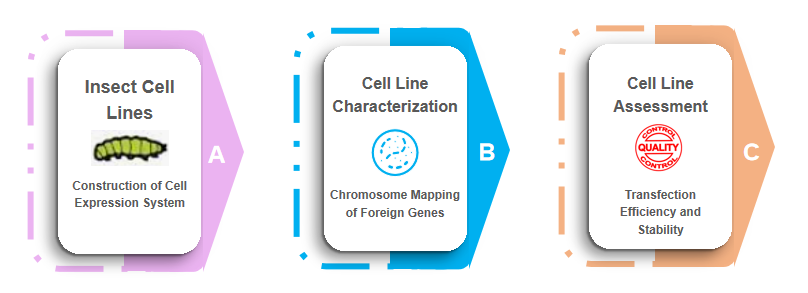Insect Cells Expression System
Creative Bioarray provides comprehensive FISH solutions for the development of insect cell line expression systems and the genetic analysis of insect cell-based expression systems. Our FISH technical service platform is committed to providing the best comprehensive analysis solutions to help customers achieve visual analysis such as gene mapping and expression analysis. Our molecular platform also has the capability of relevant protein level analysis and can provide combined services of FISH and IHC. The high-quality service team and perfect equipment platform give us the confidence to provide customers with high-quality FISH analysis and testing services.
Insect and Insect Cells Expression System
Fluorescence in situ hybridization (FISH) is a tool used in many insect populations, ranging from studies focused on insects of medical and agricultural interest (such as methods for introducing foreign genes) to the use of specific probes (such as 18S and repetitive DNA). Insect cells transfected with heterologous DNA can be used to assess the functional properties of genes that have been isolated or mutated in vitro. Optimized transfection systems for the introduction of exogenous gene expression into cultured insect cells are becoming increasingly important for generating stably transformed cell lines and for studying and improving transient heterologous protein expression using in vitro systems. Insect cell-based systems for large-scale production of recombinant proteins have become indispensable for biotechnology, pharmaceutical and industrial applications. Additional continuous cell lines have been established from a large number of insect species, mainly from the order Lepidoptera and Diptera. For example, cell lines from Spodoptera frugiperda and Spodoptera frugiperda have been widely used in commercial and research laboratories for baculovirus transient gene expression studies and transgenic cell lines. However, a large number of other insect cell lines represent a largely untapped resource.
 Fig 1. localization of the primary symbiont Portiera and the secondary symbiont Rickettsia. (Kliot A, et al. 2016)
Fig 1. localization of the primary symbiont Portiera and the secondary symbiont Rickettsia. (Kliot A, et al. 2016)
FISH Analysis in Insect Expression Cell Line Development
We offer comprehensive FISH solutions for research and applications in insect cell-based protein expression systems. A large number of other insect cell lines represent a largely untapped resource. Transfection of foreign genes into insect cells is the first step in obtaining transient or stable expression of heterologous proteins. Many transfection methods originally developed for mammalian cell lines have been adapted for use in insect cells, but the conditions required for optimal transfection efficiency can vary widely between vertebrate and invertebrate cell lines. Our FISH solutions can aid in the development of insect cell line resources as well as the development of more insect expression systems. Among the main parameters that can be optimized and studied during transfection, the expression level of heterologous proteins can be assessed by the FISH method. FISH probing provides a non-invasive, culture-independent method for identifying, quantifying, localizing, and spatially distributing several cellular targets, including nucleic acids, proteins, cell membranes, vesicles, and more. Our FISH services are used to detect cytogenetic analysis of chromosomes and their aberrations, diversity, etc., and to study their role in various organisms and different life stages of cell development.
 Fig 2. FISH detection of insect cell expression systems.
Fig 2. FISH detection of insect cell expression systems.
If you are interested in our service, please contact us for cooperation. We look forward to cooperating with you in the near future.
Reference
- Kliot A, Ghanim M. Fluorescent in situ hybridization for the localization of viruses, bacteria and other microorganisms in insect and plant tissues[J]. Methods, 2016, 98: 74-81.
All products and services on this website are only suitable for non-medical purposes.


 Fig 1. localization of the primary symbiont Portiera and the secondary symbiont Rickettsia. (Kliot A, et al. 2016)
Fig 1. localization of the primary symbiont Portiera and the secondary symbiont Rickettsia. (Kliot A, et al. 2016) Fig 2. FISH detection of insect cell expression systems.
Fig 2. FISH detection of insect cell expression systems.


